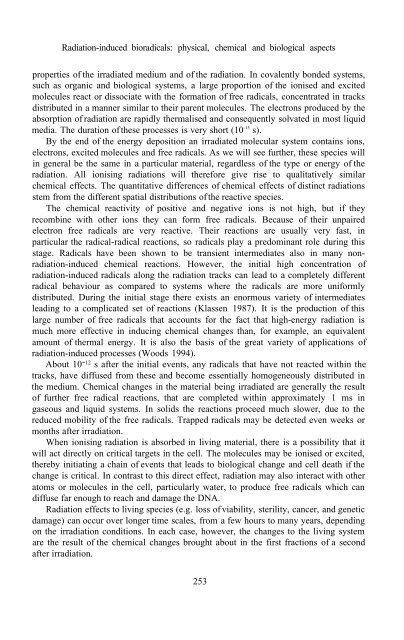Physics And Chemistry Basis Of Biotechnology - De Cuyper - tiera.ru
Physics And Chemistry Basis Of Biotechnology - De Cuyper - tiera.ru
Physics And Chemistry Basis Of Biotechnology - De Cuyper - tiera.ru
Create successful ePaper yourself
Turn your PDF publications into a flip-book with our unique Google optimized e-Paper software.
Radiation-induced bioradicals: physical, chemical and biological aspects<br />
properties of the irradiated medium and of the radiation. In covalently bonded systems,<br />
such as organic and biological systems, a large proportion of the ionised and excited<br />
molecules react or dissociate with the formation of free radicals, concentrated in tracks<br />
distributed in a manner similar to their parent molecules. The electrons produced by the<br />
absorption of radiation are rapidly thermalised and consequently solvated in most liquid<br />
media. The duration of these processes is very short (10 -15 s).<br />
By the end of the energy deposition an irradiated molecular system contains ions,<br />
electrons, excited molecules and free radicals. As we will see further, these species will<br />
in general be the same in a particular material, regardless of the type or energy of the<br />
radiation. All ionising radiations will therefore give rise to qualitatively similar<br />
chemical effects. The quantitative differences of chemical effects of distinct radiations<br />
stem from the different spatial distributions of the reactive species.<br />
The chemical reactivity of positive and negative ions is not high, but if they<br />
recombine with other ions they can form free radicals. Because of their unpaired<br />
electron free radicals are very reactive. Their reactions are usually very fast, in<br />
particular the radical-radical reactions, so radicals play a predominant role during this<br />
stage. Radicals have been shown to be transient intermediates also in many nonradiation-induced<br />
chemical reactions. However, the initial high concentration of<br />
radiation-induced radicals along the radiation tracks can lead to a completely different<br />
radical behaviour as compared to systems where the radicals are more uniformly<br />
distributed. During the initial stage there exists an enormous variety of intermediates<br />
leading to a complicated set of reactions (Klassen 1987). It is the production of this<br />
large number of free radicals that accounts for the fact that high-energy radiation is<br />
much more effective in inducing chemical changes than, for example, an equivalent<br />
amount of thermal energy. It is also the basis of the great variety of applications of<br />
radiation-induced processes (Woods 1994).<br />
About 10 -12 s after the initial events, any radicals that have not reacted within the<br />
tracks, have diffused from these and become essentially homogeneously distributed in<br />
the medium. Chemical changes in the material being irradiated are generally the result<br />
of further free radical reactions, that are completed within approximately 1 ms in<br />
gaseous and liquid systems. In solids the reactions proceed much slower, due to the<br />
reduced mobility of the free radicals. Trapped radicals may be detected even weeks or<br />
months after irradiation.<br />
When ionising radiation is absorbed in living material, there is a possibility that it<br />
will act directly on critical targets in the cell. The molecules may be ionised or excited,<br />
thereby initiating a chain of events that leads to biological change and cell death if the<br />
change is critical. In contrast to this direct effect, radiation may also interact with other<br />
atoms or molecules in the cell, particularly water, to produce free radicals which can<br />
diffuse far enough to reach and damage the DNA.<br />
Radiation effects to living species (e.g. loss of viability, sterility, cancer, and genetic<br />
damage) can occur over longer time scales, from a few hours to many years, depending<br />
on the irradiation conditions. In each case, however, the changes to the living system<br />
are the result of the chemical changes brought about in the first fractions of a second<br />
after irradiation.<br />
253












